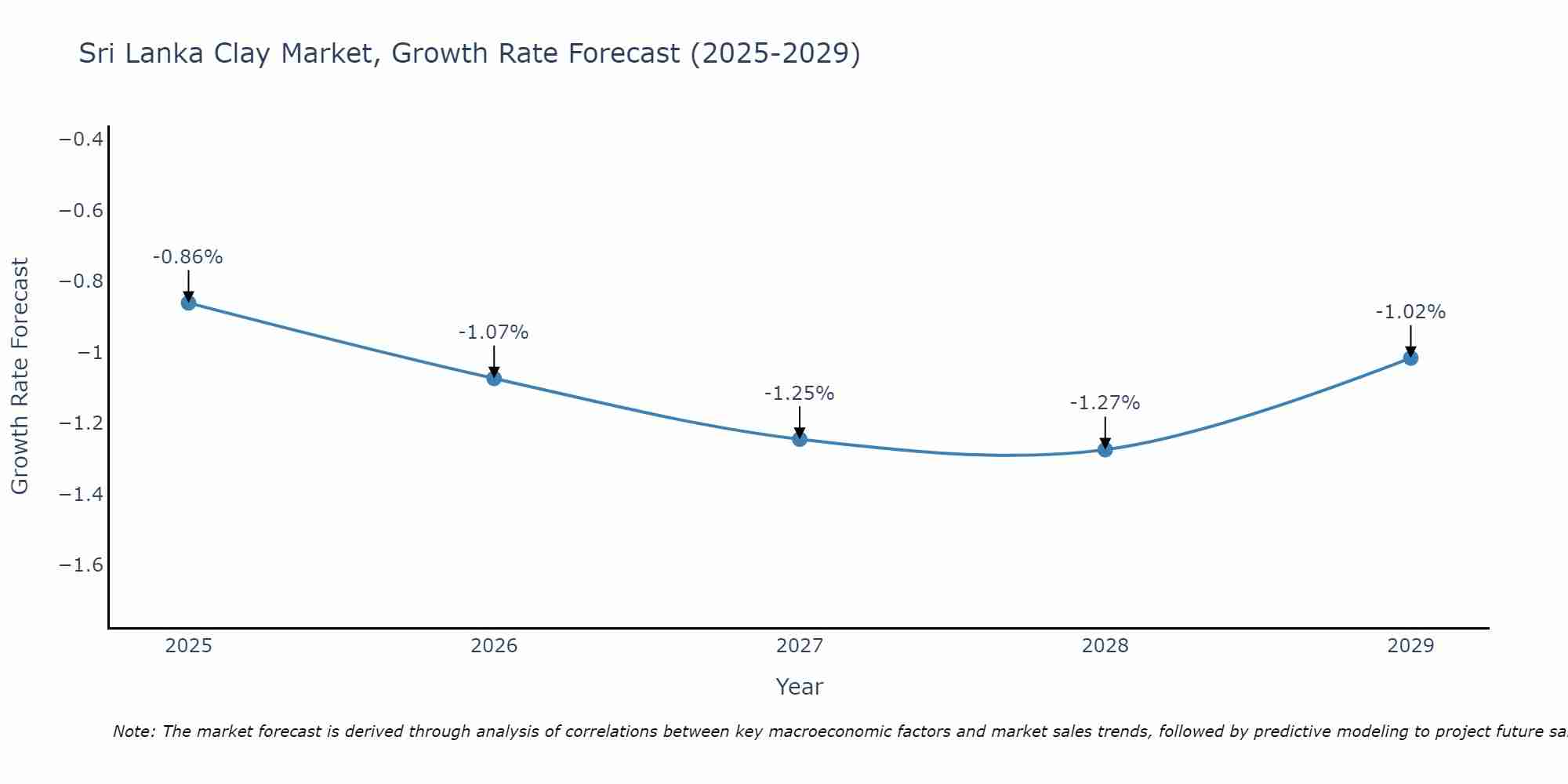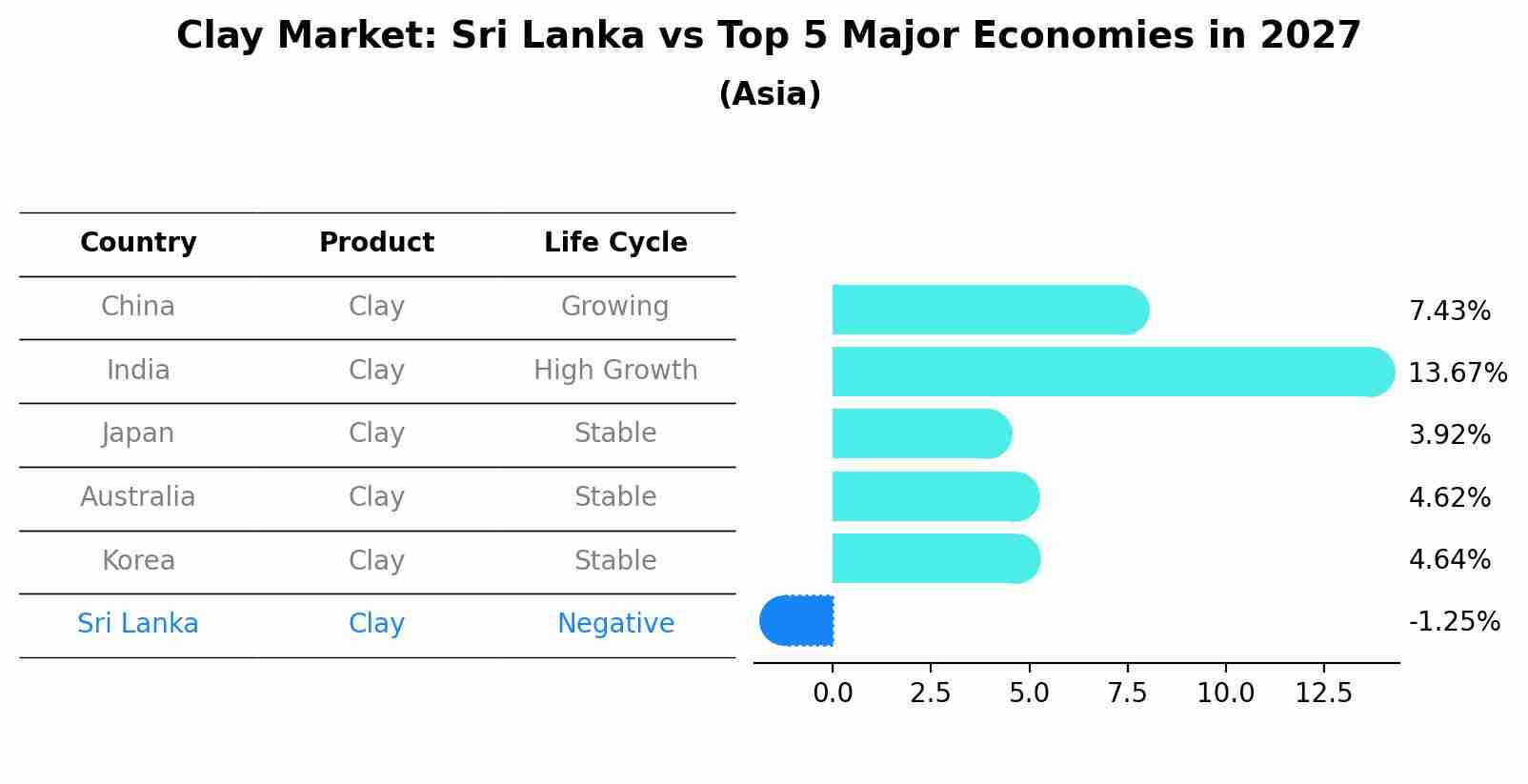Sri Lanka Clay Market Outlook | Analysis, Companies, Size, Forecast, COVID-19 IMPACT, Industry, Growth, Revenue, Trends, Share & Value
| Product Code: ETC318991 | Publication Date: Aug 2022 | Updated Date: Aug 2025 | Product Type: Market Research Report | |
| Publisher: 6Wresearch | No. of Pages: 75 | No. of Figures: 35 | No. of Tables: 20 | |
Sri Lanka Clay Market Size Growth Rate
The Sri Lanka Clay Market is projected to witness mixed growth rate patterns during 2025 to 2029. Starting high at -0.86% in 2025, the market steadily declines to -1.02% by 2029.

Clay Market: Sri Lanka vs Top 5 Major Economies in 2027 (Asia)
By 2027, Sri Lanka's Clay market is forecasted to achieve a negative growth rate of -1.25%, with China leading the Asia region, followed by India, Japan, Australia and South Korea.

Sri Lanka Clay Market Overview
Clay holds significant importance in various industries in Sri Lanka, including construction, ceramics, and pharmaceuticals. The Sri Lankan clay market encompasses both natural clay deposits and processed clay products. The availability and quality of clay influence its use in pottery, brick-making, and as a raw material for manufacturing refractories. The market dynamics are shaped by factors such as mining regulations, environmental considerations, and demand from construction and industrial sectors.
Drivers of the market
The Sri Lankan clay market is driven by its extensive applications in construction, ceramics, and the pharmaceutical industry. Drivers include the growing construction sector, urbanization trends, and infrastructure development projects across the country. Additionally, the market benefits from the availability of diverse clay types suitable for different industrial uses, coupled with increasing investments in clay mining and processing technologies.
Challenges of the market
In Sri Lanka, the clay market struggles with issues such as environmental regulations concerning mining practices, variability in clay quality and availability, and competition from alternative materials. Additionally, logistical challenges in transportation and infrastructure deficiencies impact the industry`s operational efficiency.
Government Policy of the market
Policies governing mining permits, environmental impact assessments, and export regulations are critical for the clay market. The government`s policies on land use, mineral extraction, and taxation can significantly influence production costs and market competitiveness.
Key Highlights of the Report:
- Sri Lanka Clay Market Outlook
- Market Size of Sri Lanka Clay Market, 2021
- Forecast of Sri Lanka Clay Market, 2028
- Historical Data and Forecast of Sri Lanka Clay Revenues & Volume for the Period 2018 - 2028
- Sri Lanka Clay Market Trend Evolution
- Sri Lanka Clay Market Drivers and Challenges
- Sri Lanka Clay Price Trends
- Sri Lanka Clay Porter's Five Forces
- Sri Lanka Clay Industry Life Cycle
- Historical Data and Forecast of Sri Lanka Clay Market Revenues & Volume By Application for the Period 2018 - 2028
- Historical Data and Forecast of Sri Lanka Clay Market Revenues & Volume By Tableware for the Period 2018 - 2028
- Historical Data and Forecast of Sri Lanka Clay Market Revenues & Volume By Sanitary ware for the Period 2018 - 2028
- Historical Data and Forecast of Sri Lanka Clay Market Revenues & Volume By Medical applications for the Period 2018 - 2028
- Historical Data and Forecast of Sri Lanka Clay Market Revenues & Volume By End Use for the Period 2018 - 2028
- Historical Data and Forecast of Sri Lanka Clay Market Revenues & Volume By Ceramic and for the Period 2018 - 2028
- Historical Data and Forecast of Sri Lanka Clay Market Revenues & Volume By Non-ceramic for the Period 2018 - 2028
- Sri Lanka Clay Import Export Trade Statistics
- Market Opportunity Assessment By Application
- Market Opportunity Assessment By End Use
- Sri Lanka Clay Top Companies Market Share
- Sri Lanka Clay Competitive Benchmarking By Technical and Operational Parameters
- Sri Lanka Clay Company Profiles
- Sri Lanka Clay Key Strategic Recommendations
Frequently Asked Questions About the Market Study (FAQs):
1 Executive Summary |
2 Introduction |
2.1 Key Highlights of the Report |
2.2 Report Description |
2.3 Market Scope & Segmentation |
2.4 Research Methodology |
2.5 Assumptions |
3 Sri Lanka Clay Market Overview |
3.1 Sri Lanka Country Macro Economic Indicators |
3.2 Sri Lanka Clay Market Revenues & Volume, 2021 & 2028F |
3.3 Sri Lanka Clay Market - Industry Life Cycle |
3.4 Sri Lanka Clay Market - Porter's Five Forces |
3.5 Sri Lanka Clay Market Revenues & Volume Share, By Application, 2021 & 2028F |
3.6 Sri Lanka Clay Market Revenues & Volume Share, By End Use, 2021 & 2028F |
4 Sri Lanka Clay Market Dynamics |
4.1 Impact Analysis |
4.2 Market Drivers |
4.2.1 Growing demand for eco-friendly and sustainable construction materials |
4.2.2 Increasing investments in infrastructure development projects in Sri Lanka |
4.2.3 Rising awareness about the benefits of using clay products in construction |
4.3 Market Restraints |
4.3.1 Fluctuating raw material prices impacting production costs |
4.3.2 Competition from alternative construction materials like concrete and steel |
4.3.3 Regulatory challenges related to environmental standards and permits |
5 Sri Lanka Clay Market Trends |
6 Sri Lanka Clay Market, By Types |
6.1 Sri Lanka Clay Market, By Application |
6.1.1 Overview and Analysis |
6.1.2 Sri Lanka Clay Market Revenues & Volume, By Application, 2018 - 2028F |
6.1.3 Sri Lanka Clay Market Revenues & Volume, By Tableware, 2018 - 2028F |
6.1.4 Sri Lanka Clay Market Revenues & Volume, By Sanitary ware, 2018 - 2028F |
6.1.5 Sri Lanka Clay Market Revenues & Volume, By Medical applications, 2018 - 2028F |
6.2 Sri Lanka Clay Market, By End Use |
6.2.1 Overview and Analysis |
6.2.2 Sri Lanka Clay Market Revenues & Volume, By Ceramic and, 2018 - 2028F |
6.2.3 Sri Lanka Clay Market Revenues & Volume, By Non-ceramic, 2018 - 2028F |
7 Sri Lanka Clay Market Import-Export Trade Statistics |
7.1 Sri Lanka Clay Market Export to Major Countries |
7.2 Sri Lanka Clay Market Imports from Major Countries |
8 Sri Lanka Clay Market Key Performance Indicators |
8.1 Percentage increase in the adoption of clay products in construction projects |
8.2 Number of new infrastructure projects utilizing clay materials |
8.3 Average production cost per unit of clay product |
8.4 Percentage of market share held by clay products compared to alternative materials |
8.5 Rate of compliance with environmental regulations and standards |
9 Sri Lanka Clay Market - Opportunity Assessment |
9.1 Sri Lanka Clay Market Opportunity Assessment, By Application, 2021 & 2028F |
9.2 Sri Lanka Clay Market Opportunity Assessment, By End Use, 2021 & 2028F |
10 Sri Lanka Clay Market - Competitive Landscape |
10.1 Sri Lanka Clay Market Revenue Share, By Companies, 2021 |
10.2 Sri Lanka Clay Market Competitive Benchmarking, By Operating and Technical Parameters |
11 Company Profiles |
12 Recommendations |
13 Disclaimer |
- Single User License$ 1,995
- Department License$ 2,400
- Site License$ 3,120
- Global License$ 3,795
Search
Related Reports
- ASEAN and Thailand Brain Health Supplements Market (2025-2031) | Strategy, Consumer Insights, Analysis, Investment Trends, Opportunities, Growth, Size, Share, Industry, Revenue, Segments, Value, Segmentation, Supply, Forecast, Restraints, Outlook, Competition, Drivers, Trends, Demand, Pricing Analysis, Competitive, Strategic Insights, Companies, Challenges
- ASEAN Bearings Market (2025-2031) | Strategy, Consumer Insights, Analysis, Investment Trends, Opportunities, Growth, Size, Share, Industry, Revenue, Segments, Value, Segmentation, Supply, Forecast, Restraints, Outlook, Competition, Drivers, Trends, Demand, Pricing Analysis, Competitive, Strategic Insights, Companies, Challenges
- Europe Flooring Market (2025-2031) | Outlook, Share, Industry, Trends, Forecast, Companies, Revenue, Size, Analysis, Growth & Value
- Saudi Arabia Manlift Market (2025-2031) | Outlook, Size, Growth, Trends, Companies, Industry, Revenue, Value, Share, Forecast & Analysis
- Uganda Excavator, Crane, and Wheel Loaders Market (2025-2031) | Strategy, Consumer Insights, Analysis, Investment Trends, Opportunities, Growth, Size, Share, Industry, Revenue, Segments, Value, Segmentation, Supply, Forecast, Restraints, Outlook, Competition, Drivers, Trends, Demand, Pricing Analysis, Competitive, Strategic Insights, Companies, Challenges
- Rwanda Excavator, Crane, and Wheel Loaders Market (2025-2031) | Strategy, Consumer Insights, Analysis, Investment Trends, Opportunities, Growth, Size, Share, Industry, Revenue, Segments, Value, Segmentation, Supply, Forecast, Restraints, Outlook, Competition, Drivers, Trends, Demand, Pricing Analysis, Competitive, Strategic Insights, Companies, Challenges
- Kenya Excavator, Crane, and Wheel Loaders Market (2025-2031) | Strategy, Consumer Insights, Analysis, Investment Trends, Opportunities, Growth, Size, Share, Industry, Revenue, Segments, Value, Segmentation, Supply, Forecast, Restraints, Outlook, Competition, Drivers, Trends, Demand, Pricing Analysis, Competitive, Strategic Insights, Companies, Challenges
- Angola Excavator, Crane, and Wheel Loaders Market (2025-2031) | Strategy, Consumer Insights, Analysis, Investment Trends, Opportunities, Growth, Size, Share, Industry, Revenue, Segments, Value, Segmentation, Supply, Forecast, Restraints, Outlook, Competition, Drivers, Trends, Demand, Pricing Analysis, Competitive, Strategic Insights, Companies, Challenges
- Israel Intelligent Transport System Market (2025-2031) | Strategy, Consumer Insights, Analysis, Investment Trends, Opportunities, Growth, Size, Share, Industry, Revenue, Segments, Value, Segmentation, Supply, Forecast, Restraints, Outlook, Competition, Drivers, Trends, Demand, Pricing Analysis, Competitive, Strategic Insights, Companies, Challenges
- Uganda Precast and Aggregate Market (2025-2031) | Strategy, Consumer Insights, Analysis, Investment Trends, Opportunities, Growth, Size, Share, Industry, Revenue, Segments, Value, Segmentation, Supply, Forecast, Restraints, Outlook, Competition, Drivers, Trends, Demand, Pricing Analysis, Competitive, Strategic Insights, Companies, Challenges
Industry Events and Analyst Meet
Our Clients
Whitepaper
- Middle East & Africa Commercial Security Market Click here to view more.
- Middle East & Africa Fire Safety Systems & Equipment Market Click here to view more.
- GCC Drone Market Click here to view more.
- Middle East Lighting Fixture Market Click here to view more.
- GCC Physical & Perimeter Security Market Click here to view more.
6WResearch In News
- Doha a strategic location for EV manufacturing hub: IPA Qatar
- Demand for luxury TVs surging in the GCC, says Samsung
- Empowering Growth: The Thriving Journey of Bangladesh’s Cable Industry
- Demand for luxury TVs surging in the GCC, says Samsung
- Video call with a traditional healer? Once unthinkable, it’s now common in South Africa
- Intelligent Buildings To Smooth GCC’s Path To Net Zero













